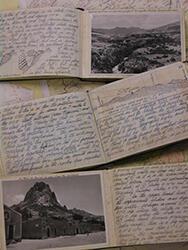Preservation of Paper Records

Paper records containing information about the nature of repository holdings and the data that are derived from them are key to the historical roots of sample collections. Widely available digital information and data can often be linked to original paper records.
Translating Information from Paper to Digital Media
Extraction of information from paper records may be a process that occurs in stages, with continual discovery of new information contained in the original paper documents. The USGS Library is digitizing many paper documents, including field notebooks, and out of print volumes. For the time being, the paper materials be retained and many of the digital materials made available to researchers. Providing digital copies, instead of paper materials, reduces time (not having to find items) and wear of fragile paper documents.
Physical storage media for the digital records that supersede paper records may not have indefinite robustness and unlimited lifetimes. Digital records may be subject to deterioration for physical reasons, such as manufacturing defects, handling, temperature, and magnetic fields. It has long been recognized that digital records may become eventually inaccessible as hardware and software become obsolete or are not supported.
At the Alaska Geological Materials Center (GMC) it is recognized that information contained on older paper records may become ambiguous or indecipherable to contemporary users. It has been found that senior, typically retired volunteers, may have familiarity from previous professional experience with the particular information or with the idiosyncratic original styles of recording and description which can be found in older paper records. The GMC has maintained a long-term program of seeking out volunteers who may have specific institutional memory, or experience with legacy data types or information to aid in translating information to digital formats.
Scanning, rather than transcription, of paper records is preferred at most repositories. At the Kentucky Geological Survey, all paper documents are placed after scanning in heavy duty manila envelopes, which are sealed and archived in metal filing cabinets. When full, an individual cabinet drawer is sealed and stored in a safe common area. Sealed paper records are not publically available due to concerns about irreversible deterioration from acids and oils on clients’ hands, possible misfiling after access, as well as potential theft. Digital copies of scanned paper records are accessible online.
Applying optical character recognition (OCR) to scanned documents increases their searchability and usefulness in extracting text and information. OCR technology is now widely-available through Portable Document Format (PDF) creating and reading software and is recommended for use on scanned records prior to release.
Proprietary Records
Paper records, like digital records, may be restricted for varying time periods after incorporation into holdings due to their confidential or proprietary nature, or because of involvement in litigation. A recurrent problem at repositories is that records may not be re-integrated into open access holdings after periods of confidentiality expire. The purposeful exclusion, at the time of conversion of paper to digital, of some records from open holdings may result in permanent non-availability of many relevant records after the time of confidentiality ends. The need to monitor the ending of periods of confidentiality is increasingly recognized, with the goal of recovering previously-restricted data. The NGGDPP encourages public access to preserved data and material to promote scientific research and disallows use of NGGDPP funding for preserving proprietary records that are not made publicly accessible.
Microfilm
Microfiche and microfilm records are conceptually similar to paper records, and are their immediate technological successor, although they are widely regarded as increasingly obsolete in view of digital alternatives. Most repositories retain, and attempt to keep in good repair, older optical-mechanical devices for reading fiche and film.

